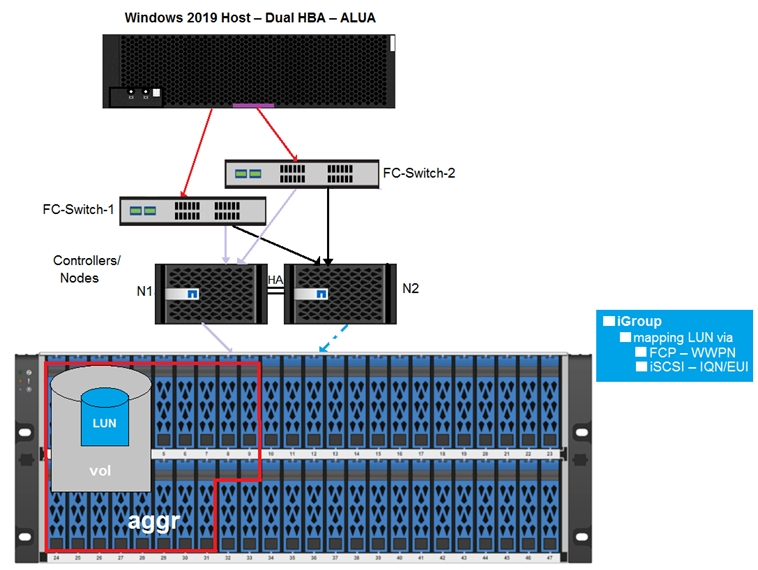Click the Exhibit button.

The exhibit shows a Windows 2019 server with two FC HBAs using ALUA.
How many paths to LUN1 are active/optimized? (Choose the best answer.)
Click the Exhibit button.

The exhibit shows a Windows 2019 server with two FC HBAs using ALUA.
How many paths to LUN1 are active/optimized? (Choose the best answer.)
In a configuration with a Windows 2019 server using ALUA (Asymmetric Logical Unit Access) and two Fibre Channel HBAs connected through dual FC switches to a dual-controller setup (Nodes N1 and N2), the number of active/optimized paths to a LUN is determined by the controller that owns the LUN. In the given diagram, the LUN is hosted on N1, and each HBA from the host can reach N1 through one of the FC switches. This creates two active/optimized paths directly from the host to N1. Therefore, the correct answer is 2.
What is the default RAID policy for aggregates created with 10 TB disk drives? (Choose the best answer.)
The default RAID policy for aggregates created with 10 TB disk drives is RAID-DP. This is because RAID-DP (RAID Double Parity) is the standard and recommended RAID type by NetApp for providing data protection and redundancy, particularly with larger drives that have a higher risk of failure. RAID-DP can handle two concurrent disk failures, making it more reliable for large capacity drives compared to other RAID types.
Your customer has an NTFS volume that they want to access over both SMB and NFS. The client explains that SMB access works fine, but the clients are unable to NFS mount the volume.
What are three reasons that would cause this issue? (Choose three.)
To enable NFS access, three primary considerations must be made. First, there must be an export-policy rule configured for the NFS clients, as this policy governs access to the volume. Second, the NFS server needs to be properly configured to handle NFS requests. Lastly, the logical interface (LIF) data protocol needs to allow NFS; otherwise, the clients cannot mount the volume using NFS. These factors ensure proper NFS functionality alongside SMB access.
You want to improve the write performance of NL-SAS volumes serving data on your ONTAP. You also want to keep the performance consistent during a possible controller failover.
In this scenario, which feature do you use? (Choose the best answer.)
To improve the write performance of NL-SAS volumes on ONTAP and ensure performance consistency during a controller failover, Flash Pool is the best feature to use. Flash Pool is an SSD-based cache that supports both read and write operations and is shared across cluster nodes, providing consistent performance even in case of a failover event. Flash Cache, on the other hand, is read-only and would not improve write performance. FlexCache is designed for reducing latency in remote clusters, not for write performance or failover consistency. FabricPool is used for tiering cold data to cloud storage, which is unrelated to write performance and failover scenarios.
You created a new SVM with two NFS data volumes. You have a Linux host on the same subnet as the SVM that is able to NFS mount, however a Linux host on a different subnet is not able to NFS mount. You confirmed that the export policy rules are correct.
In this scenario, which configuration will solve the mount failure? (Choose the best answer.)
Since a Linux host on the same subnet is able to mount the NFS data volume, it indicates that the NFS server is indeed configured properly on the SVM. The issue likely lies with the network configuration preventing the host on a different subnet from reaching the SVM. Hence, the missing SVM default network route could cause the mount failure, as it might not know the correct route to the different subnet.